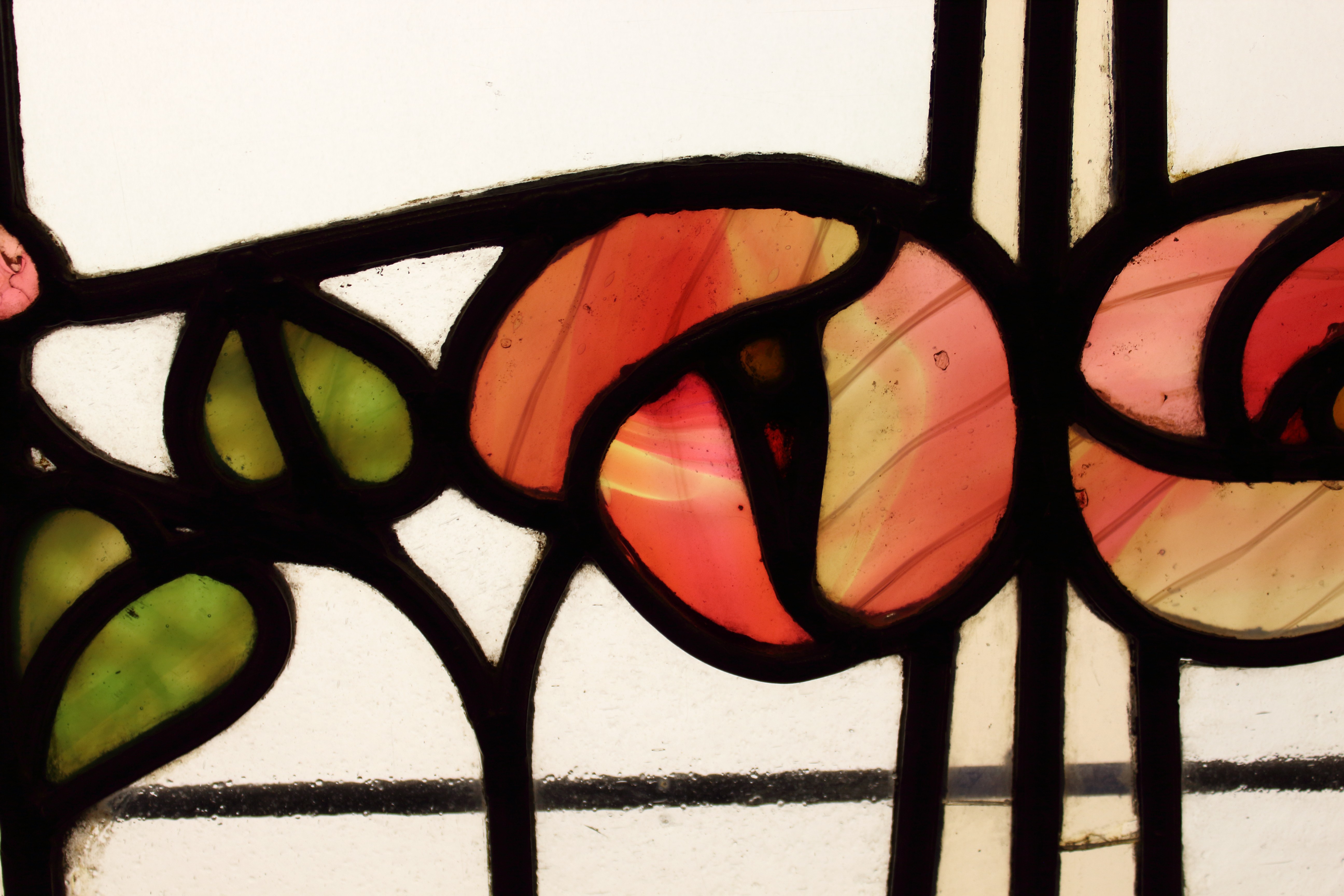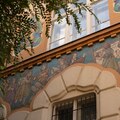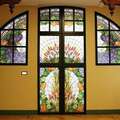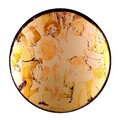Tiffany was one of the most significant artists of his time, who—similarly to Miksa Róth—masterfully combined applied arts with fine arts in his creations.

Louis Comfort Tiffany was born in 1848 in New York, as the son of Charles Lewis Tiffany, the founder of the famous Tiffany & Co. jewelry house. He began his career as a painter, learning the craft during study trips across Europe, North America, and North Africa (1). However, his attention gradually turned toward applied arts, particularly glass art. His artistic vision was shaped by the British Arts and Crafts movement and the emerging Art Nouveau style at the turn of the century. In 1892, Tiffany established his own workshop, where he began experimenting with innovative glassmaking techniques. (2). One of his major achievements was the invention of Favrile glass in 1894. The name means “handmade,” and the material is known for its rich, iridescent surface and internal coloring—achieved not by painting the surface, but by infusing color during the glassmaking process.
Favrile glass quickly became Tiffany’s trademark and is often referred to as “Tiffany glass”. He used it to create a wide range of objects, including vases, goblets, bowls, stained glass windows, and the iconic Tiffany lamps, which remain popular to this day. (3). A distinctive feature of his decorative glass was its color effect: he combined the luster of mother-of-pearl with the iridescence of glass, achieved through the deliberate mixing of different types of glass (4).
Beyond the creation of utilitarian objects, Louis Comfort Tiffany also undertook the artistic decoration of entire interiors in both private American residences and public institutions. One notable example is the Blue and Red Room of the White House. The Blue Room—also known as the Oval Office—is still the official office of the President of the United States and a symbol of presidential power. The Red Room serves as a reception area and is notable for retaining the amaranth color chosen by Tiffany, despite several renovations since the 1880s (5).
Interior decoration was so close to Tiffany’s heart that he participated in the 1893 Chicago World’s Fair with the Tiffany Chapel, a Byzantine-style interior that he designed in its entirety—including the stained glass windows, mosaics, wrought iron details, furniture, and chandeliers (6)(7). He continued to impress audiences at international exhibitions, winning a gold medal at the 1900 Paris Exposition for his artistic and technical innovations, particularly for his pioneering use of materials. At the expo, he exhibited Tiffany lamps, enamels, mosaics, glassworks, and stained glass windows, including The Four Seasons window, which embodied the beauty of nature. The piece symbolized the cycle of life —birth, aging, death, and rebirth— highlighting both the beauty of nature and Tiffany’s artistic genius.
His success was also greatly supported by the artists—both designers and craftsmen—working in his studio. Tiffany not only experimented with various glass techniques but also with studio management. In 1892, he established the Women’s Glass Cutting Department, recruiting members from local applied arts schools. Starting with just six employees, the department grew rapidly, and within two years, 40 to 50 women were working in all areas of glass production. They became known as the “Tiffany Girls.” One of the most notable figures among them was Clara Driscoll (1861–1944), one of Tiffany’s most prolific designers. She was responsible for many of the studio’s stained glass lamp designs, though she never got due acknowledgement as her work was always credited to Tiffany himself. Her contributions only came to light in a 2007 study that examined her letters and revealed her key role in the studio’s success. One of her most iconic creations was the Wisteria lamp, designed in the Art Nouveau style. It was the studio’s best-selling piece for quite a while, and like many Tiffany works, celebrates the beauty of the natural world.
Despite his many achievements, Tiffany’s career ended on a somber note. During the Great Depression in 1932, his glass studio was forced to close due to declining demand in which changing artistic tastes also played a role. Tiffany passed away just a year later, in 1933—symbolically marking not only the end of a life, but the close of an artistic era.
__
Notes:
1 Tiffany & Co.: Louis Comfort Tiffany. Founder’s Scion Makes His Mark on the World of Art and Design. https://press.tiffany.com/spokespeople/louis-comfort-tiffany/ Retrieved May 30, 2025
2 Alice Cooney Frelinghuysen, Monica Obniski: Louis Comfort Tiffany (1848–1933). The Metropolitan Museum of Art – Timeline of Art History. 2007. https://www.metmuseum.org/essays/louis-comfort-tiffany-1848-1933 Retrieved May 30, 2025
3 Miller, Judith: A huszadik századi üveg. Helikon Kiadó, 2005. 118-120.o.
4 Zádor Anna, Genthon István (szerk.): Louis Comfort Tiffany, In: Művészeti lexikon 4. köt., R - Z., Budapest, 1968. 547.
5 The White House Historical Association: The Red Room. https://www.whitehousehistory.org/white-house-tour/the-red-room; The White House Historical Association: The Blue Room. https://www.whitehousehistory.org/white-house-tour/the-blue-room Retrieved June 9, 2025
6 The Charles Hosmer Morse Museum of American Art: Tiffany Chapel. https://morsemuseum.org/collection-highlights/architectural-ornament/tiffany-chapel/ Retrieved June 9, 2025
7 The Charles Hosmer Morse Museum of American Art: Tiffany Chapel. https://morsemuseum.org/louis-comfort-tiffany/tiffany-chapel/ Retrieved June 9, 2025
8 The Charles Hosmer Morse Museum of American Art: Tiffany Studios Designers. https://morsemuseum.org/louis-comfort-tiffany/tiffany-studios-designers/ Retrieved June 9, 2025
9 Marin Eidelberg, Nina Grey, Margaret K. Hofer: A New Light on Tiffany: Clara Driscoll and The Tiffany Girls. New York Historical Society, New York, 2007.
A bejegyzés trackback címe:
Kommentek:
A hozzászólások a vonatkozó jogszabályok értelmében felhasználói tartalomnak minősülnek, értük a szolgáltatás technikai üzemeltetője semmilyen felelősséget nem vállal, azokat nem ellenőrzi. Kifogás esetén forduljon a blog szerkesztőjéhez. Részletek a Felhasználási feltételekben és az adatvédelmi tájékoztatóban.



